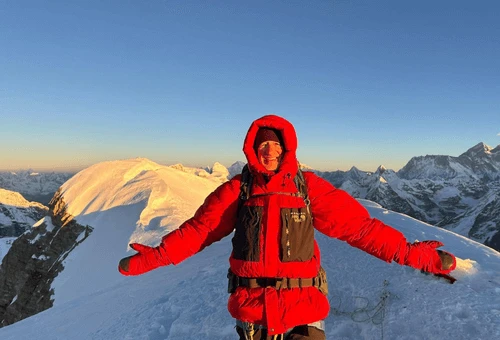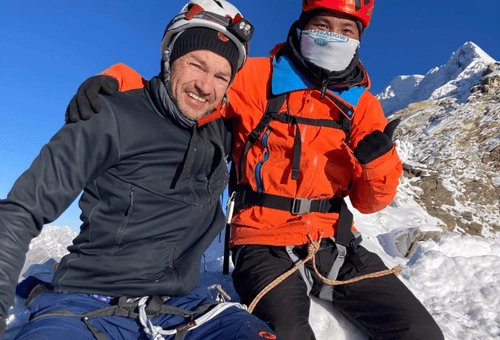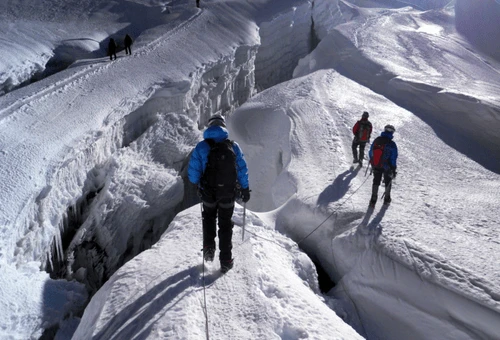Mera Peak Climbing - 12 Days
Duration:12 DaysLobuche Peak Climbing - 17 Days
Duration:17 DaysEverest Base Camp Trek with Island Peak Climbing - 18 Days
Duration:18 Days
Challenge Yourself, Conquer the Summits, Discover the Soul of the Himalayas
Nestled in the heart of the Himalayas, Nepal is a dream destination for adventurers and mountaineers around the globe. With more than 1,300 Himalayan peaks, including 33 trekking peaks officially open for climbing, Peak Climbing in Nepal offers a thrilling opportunity to ascend glaciated summits without committing to full-scale expeditions like Everest.
Whether you’re a passionate trekker looking to step up your game or an experienced climber chasing your next summit, Nepal’s climbing peaks like Island Peak, Mera Peak, and Lobuche East are your gateway to a once-in-a-lifetime experience, blending adventure, culture, and natural wonder.
Why Choose Nepal for Peak Climbing?
A Diverse Playground for Mountaineers
Nepal's unique topography and extensive range of peaks between 5,800 meters to 6,600 meters make it one of the best countries in the world for beginner and intermediate climbers. Here’s what makes it unmatched:
- Affordable Mountaineering: Climb majestic Himalayan peaks at a fraction of the cost of technical expeditions.
- Cultural Immersion: Every climbing route takes you through Sherpa villages, monasteries, and ancient trade routes.
- Acclimatization-friendly Itineraries: Trekking routes offer gradual elevation gains, aiding safe high-altitude climbing.
- Expert Sherpa Guides: Local guides with years of alpine experience lead your way with precision, safety, and heart.
Most Popular Peaks to Climb in Nepal
Nepal’s trekking peaks, classified by the Nepal Mountaineering Association (NMA), are ideal for those seeking semi-technical to technical climbs that don’t require weeks of expedition logistics.
1. Island Peak (Imja Tse) – 6,189m
Region: Everest
Difficulty: Moderate
Best For: First-time climbers
Highlights: Close views of Lhotse, Nuptse, and Ama Dablam, glacier walk, summit ridge climb
Island Peak is the perfect blend of trekking and mountaineering. After an acclimatization trek to Everest Base Camp or Chhukung, climbers ascend this classic peak that offers a real taste of high-altitude mountaineering.
2. Mera Peak – 6,476m
Region: Hinku Valley
Difficulty: Moderate to Hard
Best For: High-altitude experience with less technicality
Highlights: Panoramic views of Everest, Makalu, Cho Oyu, and Kanchenjunga
Known as the highest trekking peak in Nepal, Mera Peak is ideal for those seeking altitude rather than extreme technical challenges. A perfect choice to build confidence before attempting 7,000m or 8,000m expeditions.
3. Lobuche East – 6,119m
Region: Everest
Difficulty: Challenging
Best For: Climbers with basic mountaineering skills
Highlights: Technical ridge climb, Everest views, combination with EBC trek
Lobuche is for climbers ready to tackle mixed terrains involving rock, ice, and snow. Often used as a training climb for Everest aspirants.
4. Pisang Peak – 6,091m
Region: Annapurna
Difficulty: Moderate
Best For: Trek & climb in one trip
Highlights: Annapurna II & IV views, Tibetan culture, scenic Marsyangdi Valley
Combine this climb with the Annapurna Circuit for a full trekking and mountaineering adventure.
Cost of Peak Climbing in Nepal
Climbing costs vary depending on the peak, group size, season, and logistics. Generally, the Peak climbing Cost in Nepal starts from USD 2500 and reaches up to USD 4000 per person.
Inclusions usually cover permits, climbing guides, group equipment, transportation, meals, accommodation, and domestic flights.
What You Need for Peak Climbing
Essential Gear Checklist
Mountaineering boots (Crampon compatible)
Ice axe, harness, helmet, and carabiners
Sleeping bag (-20°C rated), down jacket, gloves
Crampons, ropes, and ascenders (some gear are provided by the Mountain Eco Trails)
Headlamp, sunglasses, first aid kit
Training & Preparation
Before attempting peak climbing in Nepal, focus on:
Cardiovascular endurance
Strength training (especially legs and core)
Previous high-altitude trekking (EBC or Annapurna Base Camp)
Familiarity with basic mountaineering techniques
Many peaks require basic rope handling, use of crampons, and glacier travel. If you’re new, opt for a pre-climb training day in Kathmandu or at base camp.
Best Time for Peak Climbing in Nepal
Two Ideal Seasons:
Spring (March to May): Stable weather, longer daylight, fewer winds
Autumn (September to November): Clear skies, excellent visibility, festive season
Avoid monsoon (June–August) due to slippery trails and avalanche risk. Winter climbs (December–February) are possible but harsh and require advanced prep.
Safety and Support You Can Trust
Climbing in the Himalayas comes with inherent risks. Mountain Eco Trails is an authorized trekking and climbing operator that you can trust confidently for the Peak climbing in Nepal:
- Licensed Sherpa climbing guides of Mountain Eco Trails
- Proper acclimatization days and a flexible Itinerary
- Oxygen cylinders and satellite phones
- Emergency evacuation planning and arrangement.
- Always prioritize safety first.
Who is Peak Climbing in Nepal For?
✅ Adventurous trekkers ready to level up
✅ Climbers aiming for 6,000 m+ summits
✅ Photographers & nature lovers seeking Himalayan panoramas
✅ Bucket list achievers looking for personal growth
You don’t need to be a pro climber—but you do need courage, fitness, and the will to rise above the clouds.




